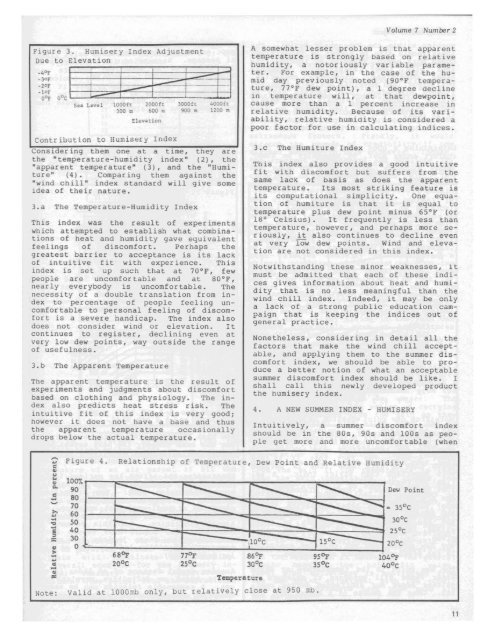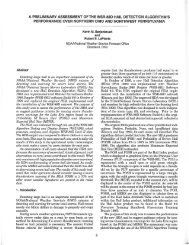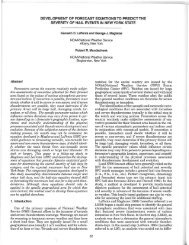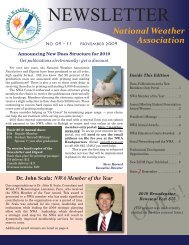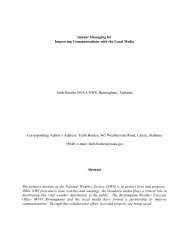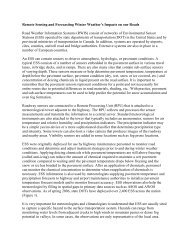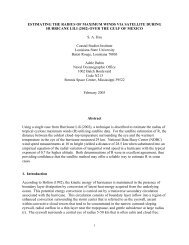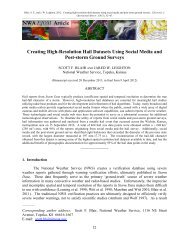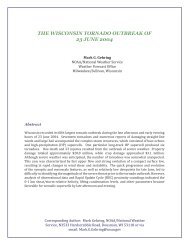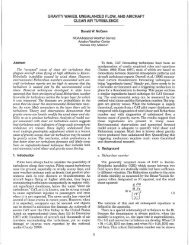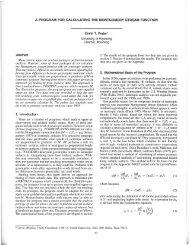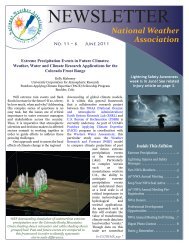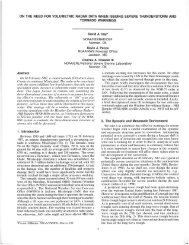The humisery and other measures of summer discomfort - National ...
The humisery and other measures of summer discomfort - National ...
The humisery and other measures of summer discomfort - National ...
Create successful ePaper yourself
Turn your PDF publications into a flip-book with our unique Google optimized e-Paper software.
Volume 7 Number 2<br />
Figure 3. Humisery Index Adjustment<br />
Due to Elevation<br />
~1~oJkt P I ~<br />
Sea Level 1000ft 2000ft 3000ft 4000ft<br />
300 m 600 0 900 m 1200 m<br />
Elevation<br />
Contribution to Humisery Index<br />
Consider ing them one at a time, they are<br />
the "temperature-humidity index" (2), the<br />
"apparent temperature" (3), <strong>and</strong> the "Humiture"<br />
(4). Comparing them against the<br />
"wind chill" index st<strong>and</strong>ard will give some<br />
idea <strong>of</strong> their nature.<br />
3.a <strong>The</strong> Temperature-Humidity Index<br />
This index was the result <strong>of</strong> exper iments<br />
which attempted to establish what combinations<br />
<strong>of</strong> heat <strong>and</strong> humidity gave equivalent<br />
feelings <strong>of</strong> <strong>discomfort</strong>. Perhaps the<br />
greatest barrier to acceptance is its la~k<br />
<strong>of</strong> intuitive fit with experience. Th1s<br />
index is set up such that at 70°F, few<br />
people are uncomfortable <strong>and</strong> at 80°F,<br />
nearly everybody is uncomfortable. <strong>The</strong><br />
necessity <strong>of</strong> a double translation from index<br />
to percentage <strong>of</strong> people feeling uncomfortable<br />
to personal feeling <strong>of</strong> <strong>discomfort</strong><br />
is a severe h<strong>and</strong>icap. <strong>The</strong> index also<br />
does not consider wind or elevation. It<br />
continues to register, declining even at<br />
very low dew points, way outside the range<br />
<strong>of</strong> usefulness.<br />
3.b <strong>The</strong> Apparent Temperature<br />
<strong>The</strong> apparent temperature is the result <strong>of</strong><br />
experiments <strong>and</strong> jUdgments about <strong>discomfort</strong><br />
based on clothing <strong>and</strong> physiology. <strong>The</strong> index<br />
also predicts heat stress risk. <strong>The</strong><br />
intuitive fit <strong>of</strong> this index is very good;<br />
however it does not have a base <strong>and</strong> thus<br />
the apparent temperature occasionally<br />
drops below the actual temperature.<br />
A somewhat lesser problem is that apparent<br />
temperature is strongly based on relative<br />
humidity, a notoriously variable parameter.<br />
For example, in the case <strong>of</strong> the humid<br />
day previously noted (90°F temperature,<br />
77°F dew point), a 1 degree decline<br />
1n temperature will, at that dewpoint,<br />
cause more than a 1 percent increase in<br />
relative hum1dity. Because <strong>of</strong> its variability,<br />
relative humidity is considered a<br />
poor factor for use in calCUlating indices.<br />
3.c <strong>The</strong> Humiture Index<br />
This index also provides a good intuitive<br />
fit with <strong>discomfort</strong> but suffers from the<br />
same lack <strong>of</strong> basis as does the apparent<br />
temperature. Its most striking feature is<br />
its computational simplicity. One equation<br />
<strong>of</strong> humiture is that it is equal to<br />
temperature plus dew point mir:tus 65°F (or<br />
18° Celsius). It frequently 1S less than<br />
temperature, however, <strong>and</strong> perhaps ~ore seriously,<br />
it also continues to dec11ne even<br />
at very low dew points. Wind <strong>and</strong> elevation<br />
are not considered in this index.<br />
Notwithst<strong>and</strong>ing these minor weaknesses, it<br />
must be admitted that each <strong>of</strong> these indices<br />
gives information about heat <strong>and</strong> humidity<br />
that is no less meaningful than the<br />
wind chill index. Indeed, it may be only<br />
a lack <strong>of</strong> a strong public education campaign<br />
that is keeping the indices out <strong>of</strong><br />
general practice.<br />
Nonetheless, considering in detail all the<br />
factors that make the wind chill acceptable,<br />
<strong>and</strong> applying them to the <strong>summer</strong> <strong>discomfort</strong><br />
index, we should be able to produce<br />
a better notion <strong>of</strong> what an acceptable<br />
<strong>summer</strong> <strong>discomfort</strong> index should be like. I<br />
shall call this newly developed product<br />
the <strong>humisery</strong> index.<br />
4. A NEW SUMMER INDEX - HUMISERY<br />
Intuitively,<br />
should be in<br />
pIe get more<br />
a <strong>summer</strong> discomfor t index<br />
the 80s, 90s <strong>and</strong> 100s as peo<strong>and</strong><br />
more uncomfor table (when<br />
c..ụ.<br />
'Z' Figure 4.<br />
..<br />
Co<br />
c<br />
..~<br />
1007<br />
90<br />
80<br />
70<br />
60<br />
50<br />
40<br />
30<br />
o<br />
---- r----<br />
----<br />
~<br />
r---- ~<br />
~""'"<br />
-<br />
Relationship <strong>of</strong> Temperature, Dew Point <strong>and</strong> Relative Humidity<br />
]lOoC 15°C<br />
..........<br />
De"..<br />
_ 35°C<br />
30 0 e<br />
2S o e<br />
20 0 e<br />
Point<br />
Note:<br />
Temperature<br />
Valid at 1000mb only, but relatively close at 950<br />
mb.<br />
11


